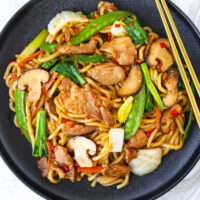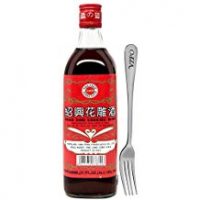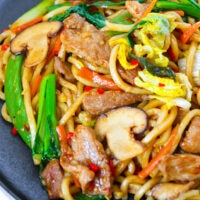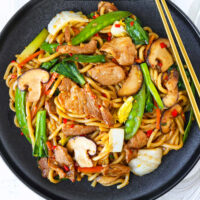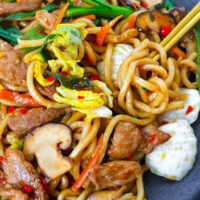 Buy Now →
Buy Now → Shanghai Style Fried Noodles
Shanghai Style Fried Noodles is made with chewy thick noodles, juicy pork slices, garlic, chilies, mushrooms, cabbage, other veggies and stir-fried in a mouthwatering savory-sweet sauce! It’s ready in 25 minutes and better than takeout!
- Prep Time: 15
- Cook Time: 10
- Total Time: 25 minutes
- Yield: 4 1x
- Category: Dinner
- Method: Stir-fry
- Cuisine: Chinese
Ingredients
Scale
For the Pork Marinade:
- 230 grams / 8.11 ounces Pork Collar Meat
- 2 TSP Low Sodium Light Soy Sauce
- 1 TSP Shao Xing Rice Wine
- 1 TSP Potato Starch (or Corn Starch)
- ¼ TSP Sesame Oil
For the Sauce:
- 1.5 TBLS Low Sodium Light Soy Sauce
- ½ TBLS Dark Soy Sauce
- ½ TBLS Shao Xing Rice Wine
- 1 TBLS Oyster Sauce
- 1 TSP White Sugar
- 1 TSP Sesame Oil
- 1 TSP Pure Chili Oil (optional – without flakes/seeds)
- 1/8 TSP Kosher Salt, to taste (see notes*)
For the Shanghai Style Fried Noodles:
- 5 Garlic Cloves – minced
- 2–10 fresh Red Chilies (Thai Bird’s Eye or any small hot red chilies), to taste – finely chopped
- 2 Spring Onion (Scallion/Green Onion) – cut into 1.5-inch pieces, white and light green parts separated from dark green parts
- 75 grams / 4 fresh Asian Brown Mushrooms (such as Shiitake) – rehydrated in bowl of water if using dried mushrooms, washed, pat-dried, thinly sliced
- 1.5 cups chopped Chinese Cabbage (Wombok/Napa Cabbage)
- 1 cup chopped Choy Sum (or other Asian Greens such as bok choy, Chinese broccoli – ‘gai lan’)
- ¼ cup julienned Carrots (about half of a small carrot)
- 50 grams / 1.75 ounces Snow Peas – ends trimmed and hairy parts removed
- 400 grams / 14 ounces pre-cooked Shanghai Noodles (or Udon Noodles – see notes*)
- 3 TBLS Canola Oil (or any other neutral cooking oil with a high smoke point)
- ¼ – ½ TSP ground White Pepper
- To Serve (optional): Chinese chili oil (with flakes/seeds – store-bought or homemade)
Instructions
Prep:
- Marinate the pork: Thinly slice the pork collar meat into strips. Add to a bowl, followed by the low sodium light soy sauce, Shao Xing rice wine, potato starch (or corn starch), and sesame oil. Mix well to combine. Set aside to marinate while you prepare the rest of the ingredients.
- Make the sauce: Whisk together the low sodium light soy sauce, dark soy sauce, Shao Xing rice wine, oyster sauce, white sugar, sesame oil, pure chili oil (if using), and kosher salt in a small measuring cup (for easier pouring) or bowl until combined well. Set aside.
- Prepare the fresh ingredients: Chop/prepare the garlic, fresh red chilies, spring onion (separate the white and light green parts from the dark green parts), mushrooms, Chinese cabbage, choy sum, carrot, and snow peas as indicated in the ‘ingredients’ section and set aside.
For the Shanghai Style Fried Noodles:
- Prepare the noodles: Bring a pot of water to a boil and add the noodles to the pot. Use tongs to grab onto the noodle cakes and gently loosen them up until the strands have separated and are tender – about 1 minute. Drain into a colander and run cold water on top to prevent sticking. Set aside. (See note 3 if using fresh or dried noodles.)
- Cook the pork: Heat 2 tablespoons canola oil in a large wok over high heat. Once hot, add the marinated pork and immediately spread out the pieces in the wok. Allow to sear for a minute, then stir-fry and allow to sear for another 30 seconds until almost fully cooked. Use a slotted spoon to transfer to a clean bowl. Remove and discard any crispy bits from the oil in the wok.
- Sauté the mushrooms: Add the remaining 1 tablespoon of canola oil to the wok and heat over high heat. Once hot, add the mushrooms and sauté for 30 seconds until starting to soften.
- Stir-fry the aromatics: Add the garlic, fresh red chilies, and spring onion white and light green parts and stir-fry for 20 seconds until fragrant.
- Stir-fry the carrots and snow peas. Add the carrots and snow peas and toss for 20 seconds to combine.
- Add the pork, noodles and sauce: Add the pork and toss briefly to combine. Then add the noodles and pour the sauce on top. Stir-fry and mix until everything is evenly coated in the sauce.
- Add the cabbage and greens: Add the cabbage, choy sum, and spring onion dark green parts and sprinkle ground white pepper to taste on top. Stir-fry continuously using a scooping motion until the veggies are slightly wilted but still have a little crunch to them. Switch off the heat.
- To Serve: Divide evenly into plates/bowls. Serve immediately while hot, and with Chinese chili oil on the side if desired.
Notes
- Pork Collar Meat. The fat that runs through the cut of pork collar makes the meat tender and juicy once cooked. However, feel free to use a lean cut of pork such as tenderloin/fillet if you prefer. Alternative protein options are thinly sliced boneless and skinless chicken breasts or thighs, beef flank or skirt steak, or shrimp/prawns. You can also use crispy pan-fried tofu cubes or a plant-based meat substitute to make this vegetarian. Be sure to use a vegetarian mushroom flavored oyster sauce for the stir-fry sauce if making this vegetarian/vegan.
- Vegetables. Feel free to customize this with other stir-fry friendly veggies you like. Some ideas are enoki mushrooms, cloud or wood ear mushrooms, sugar snap peas, Chinese yellow chives, yellow onion, bok choy, Chinese broccoli, etc.
- Shanghai Noodles. You can use fresh Shanghai noodles (available in the fridge section at Asian/Chinese supermarkets), vacuum sealed packs, or dried noodles. I used 2 x 200 grams / 7 ounce packs of vacuum sealed pre-cooked fresh Shanghai noodles. Udon noodles have a similar thick texture and can be substituted if unavailable. If using fresh Shanghai noodles, boil for 1-2 minutes only. If using dried Shanghai or udon noodles, you’ll need 200 grams / 7 ounces. Cook dried noodles according to package instructions. After preparing as needed, drain and run cold water over the noodles to prevent sticking. Then use as indicated for this recipe (follow steps 2-7).
- Kosher Salt: Use half the amount if using iodized table salt as it is more salty than kosher salt.
- See ‘Variations’ section in the post above if you’d like to customize this noodles stir-fry.
Nutrition
- Serving Size: 1 serving
- Calories: 426
- Sugar: 6.7g
- Sodium: 638mg
- Fat: 21.1g
- Saturated Fat: 3.9g
- Unsaturated Fat: 15.9g
- Trans Fat: 0.1g
- Carbohydrates: 43.7g
- Fiber: 2.7g
- Protein: 18g
- Cholesterol: 35.7mg
Find it online: https://thatspicychick.com/shanghai-style-fried-noodles/
